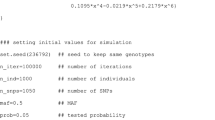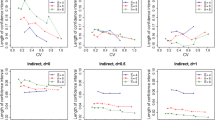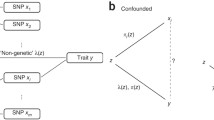Abstract
To test genetic pleiotropy, the main difficulty lies in the failure to find a test statistic and calculate its p-value for determining whether to reject the null hypothesis or not. To deal with this issue, the authors propose a quasi p-value, which plays the similar role as the usual p-value in genetic pleiotropy test. In the formula of the quasi p-value, the main task is to determine the weights. In this paper, the authors present two weighted methods based on the Bayesian rule and extend the proposed methods to study a single binary trait using a data-driven EM algorithm. Extensive simulation studies are conducted for the assessment of the two proposed methods and illustrate that the proposed methods improve the performance of power by comparing with the two-stage method. In addition, the authors apply the proposed methods to the data of tropical storms that occurred on the mainland of China since 1949, investigating the relationship between the landing site and predictive features of tropical storms, and showing that the landing site has a large influence on at least two features of typhoon.
Similar content being viewed by others
References
Solovieff N, Cotsapas C, Lee P H, et al., Pleiotropy in complex traits: Challenges and strategies, Nature Reviews Genetics, 2013, 14(7): 483–495.
Galesloot T E, Van Steen K, Kiemeney L, et al., A comparison of multivariate genome-wide association methods, Plos One, 2014, 9(4): 1–8.
Marchini J, Howie B, Myers S, et al., A new multipoint method for genome-wide association studies by imputation of genotypes, Nature Genetics, 2007, 39(7): 906–913.
Cotsapas C, Voight B F, Rossin E, et al., Pervasive sharing of genetic effects in autoimmune disease, Plos Genetics, 2011, 7(8): e1002254.
Boehm F J, Chesler E J, Yandell B S, et al., Testing pleiotropy vs. separate QTL in multiparental populations, G3-Genes Genomes Genetics, 2019, 9(7): 2317–2324.
Zhan X, Zhao N, Plantinga A, et al., Powerful genetic association analysis for common or rare variants with high-dimensional structured traits, Genetics, 2017, 206(4): 1779–1790.
Deng Y and Pan W, Conditional analysis of multiple quantitative traits based on marginal GWAS summary statistics, Genetic Epidemiology, 2017, 41(5): 427–436.
Hu N, Chen X, and Sun J, Regression analysis of length-biased and right-censored failure time data with missing covariates, Scandinavian Journal of Statistics, 2015, 42(2): 438–452.
Shriner D, Moving toward system genetics through multiple trait analysis in genome-wide association studies, Frontiers in Genetics, 2012, 16(7): 1–7.
Pitchers W, Nye J, Márquez E J, et al., A multivariate genome-wide association study of wing shape in Drosophila melanogaster, Genetics, 2019, 211(4): 1429–1447.
Schifano E, Li L, Christiani D, et al., Genome-wide association analysis for multiple continuous secondary phenotypes, American Journal of Human Genetics, 2013, 92(5): 744–759.
Tong X W, Gao F, Chen K, et al., Maximum likelihood estimation in transformed linear regression with non-normal errors, Annals of Statistics, 2019, 47(4): 1864–1892.
Zhang Y, Xu Z, Shen X, et al., Testing for association with multiple traits in generalized estimation equations, with application to neuroimaging data, NeuroImage, 2014, 96(1): 309–325.
Yang Q and Wang Y, Methods for analyzing multivariate phenotypes in genetic association studies, Journal of Probability and Statistics, 2012, 2012(358): 652569.
Tsepilov Y A, Sharapov S Z, Zaytseva O O, et al., A network-based conditional genetic association analysis of the human metabolome, Gigascience, 2018, 7(12): giy137.
Winkler T W, Günther F, Höllerer S, et al., A joint view on genetic variants for adiposity differentiates subtypes with distinct metabolic implications, Nature Communications, 2018, 9(1): 1–13.
Ferreira M A and Purcell S, A multivariate test of association, Bioinformatics, 2009, 25(1): 132–133.
Jiang Q, Zhang X, Wu M, et al., Testing economic “genetic pleiotropy” for Box-Cox linear model, Communications in Statistics — Theory and Methods, 2019, 49(19): 1–15.
Zhao Z H and Zou G H, Average estimation of semiparametric models for high-dimensional longitudinal data, Journal of Systems Science & Complexity, 2020, 33(6): 2013–2047.
Maity A, Sullivan P F, and Tzeng J Y, Multivariate phenotype association analysis by marker-set kernel machine regression, Genetic Epidemiology, 2012, 36(7): 686–695.
Liu Y, Ren M Y, and Zhang S G, Empirical likelihood test for regression coefficients in high dimensional partially linear models, Journal of Systems Science & Complexity, 2021, 34(3): 1135–1155.
Gao Q B, Du X L, Zhou X Q, et al., Asymptotic properties of maximum quasi-likelihood estimators in generalized linear models with diverging number of covariates, Journal of Systems Science & Complexity, 2018, 31(5): 1362–1376.
Hu X N, Duan X G, Pan D D, et al., A model-embedded trend test with incorporating hardyweinberg equilibrium information, Journal of Systems Science & Complexity, 2017, 30(1): 101–110.
Liu J, Pei Y, Papasian C J, et al., Bivariate association analyses for the mixture of continuous and binary traits with the use of extended generalized estimating equations, Genetic Epidemiology, 2009, 33(3): 217–227.
Schaid D, Tong X W, Larrabee B, et al., Statistical methods for testing genetic pleiotropy, Genetics, 2016, 204(2): 483–497.
Schaid D, Tong X W, Batzler A, et al., Multivariate generalized linear model for genetic pleiotropy, Biostatistics, 2019, 20(1): 111–128.
Author information
Authors and Affiliations
Corresponding author
Additional information
This paper was supported by National Key Research and Development Program of China under Grant No. 2017YFA0604903, the National Natural Science Foundation of China under Grant No. 11971064 and the Ph.D. start-up fund of Hubei University of Science and Technology under Grant No. BK201813.
Rights and permissions
About this article
Cite this article
Wu, Q., Zhong, S. & Tong, X. Genetic Pleiotropy Test by Quasi p-Value with Application to Typhoon Data in China. J Syst Sci Complex 35, 1557–1572 (2022). https://doi.org/10.1007/s11424-022-0287-5
Received:
Revised:
Published:
Issue Date:
DOI: https://doi.org/10.1007/s11424-022-0287-5




